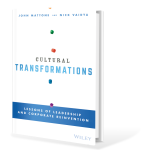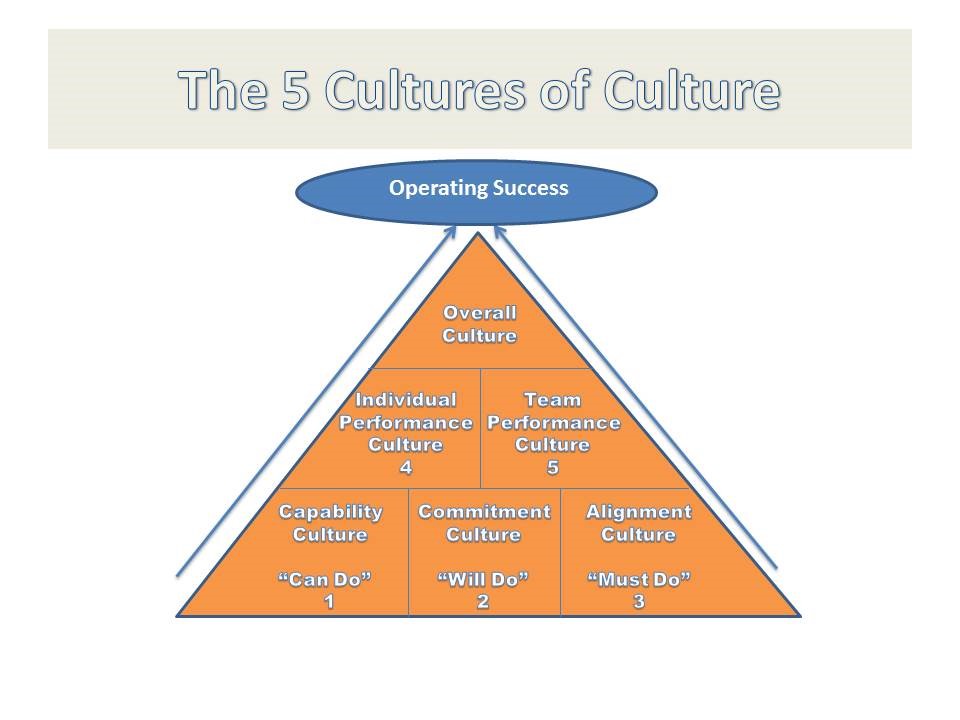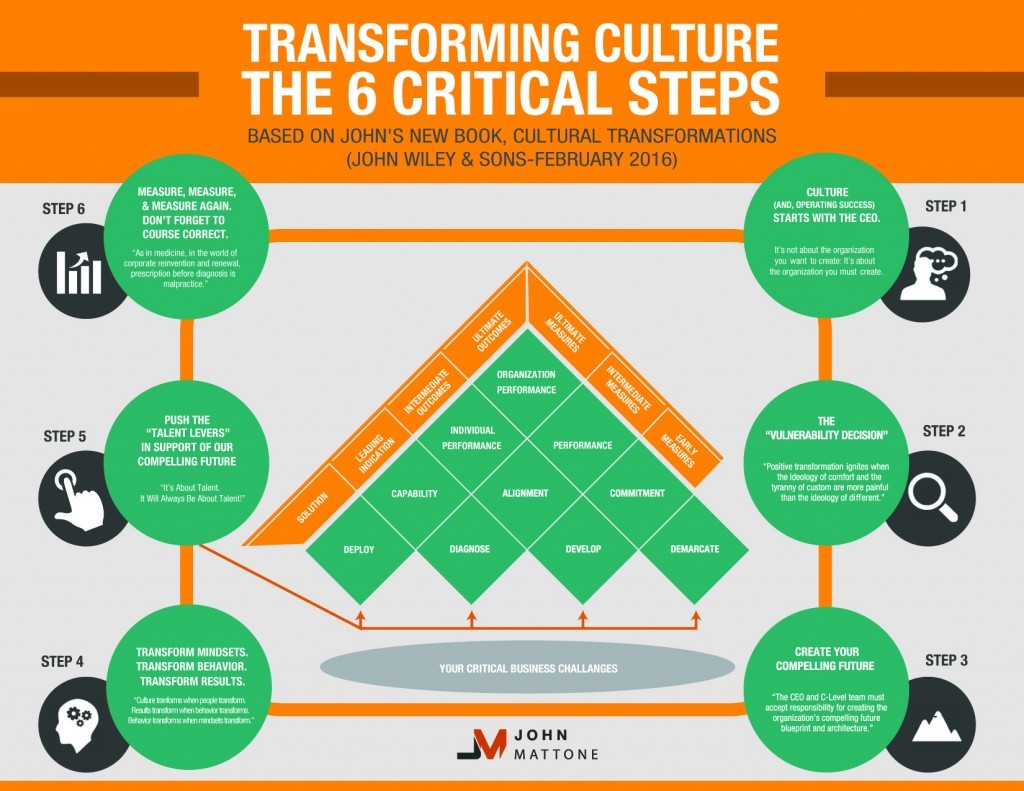How to Transform Your Culture
In all of the organizations I have had the privilege to lead, I am always thinking and focusing on culture. Culture, to me, is important both at home and at work. It is the engine that either limits potential or sustains success.
 Today it seems every forward-thinking company is focused on cultural reinvention. John Mattone and Nick Vaidya’s new book, Cultural Transformations: Lessons of Leadership and Corporate Reinvention was one that I read with great interest. Not only do the authors outline the imperative to continually transform corporate culture to stay ahead of the competition, but they also interview numerous corporate leaders to provide examples to lead the way.
Today it seems every forward-thinking company is focused on cultural reinvention. John Mattone and Nick Vaidya’s new book, Cultural Transformations: Lessons of Leadership and Corporate Reinvention was one that I read with great interest. Not only do the authors outline the imperative to continually transform corporate culture to stay ahead of the competition, but they also interview numerous corporate leaders to provide examples to lead the way.
John Mattone has been featured here before. He’s a leadership guru, a top-ranked CEO coach, and runs a top-ranked leadership blog. Whenever he contacts me, I know that I will learn something. I recently had the opportunity to talk with him about his latest work.
Culture Change is Constant
When you talk about cultural transformation, what are you referring to? Under what circumstances might a company look to transform its culture?
Always. The need to transform culture and ensure that you always have the culture in place to drive sustained operating success is a never-ending pursuit and business priority. A healthy, vibrant and mature culture will drive success and keep any organization “ahead of the curve.” So many factors are creating “disruption” in all sectors—digitization, globalization, and the need to operate at two-speeds (fast in emerging economies, slower in mature economies). Traditional differentiators like size, scope, legacy and market position are no longer differentiators. To stay ahead of the curve, CEO’s and senior teams must always be re-thinking, re-shaping, and reinventing their own purpose as well as the purpose of the enterprise. It is no longer about the company you want to create; it is now much more about the company that you must create.

Defining the Right Culture for You
How do you define what is the right culture for your organization?
You have to be passionate and diligent about measuring everything. This is the 6th step of my Cultural Transformation Model. Measuring operating metrics is part of it. Measuring the effectiveness of your talent systems, your engagement levels, and getting views from your customers and suppliers, and actually measuring what’s working and not working in your culture are all critical. Ultimately, it’s about leveraging your strengths and gifts—the positive legacy aspects of your business (and culture) and addressing the “gaps” and having a laser-focus discipline is what’s required. Sometimes, the C-level team determines based on this “world of feedback” that the company must become more innovative. This will then lead to strategies on how to recruit and select talent who possess the capability to be agile, nimble and innovative. Prescription before diagnosis is malpractice in medicine. However, I would say the same principle applies in the world of corporate reinvention and renewal.

The Role of the Leader
What role must the CEO play when it comes to cultural transformation and creating an organization’s compelling future? How can they achieve that?
Culture always starts with the CEO. It’s the 1st step in my Cultural Transformation Model. If you don’t have a CEO who is a great leader…who possesses great character, values, thinking patterns, emotional make-up, and great skills…who “walks the talk” and a CEO who has the capability and guts to think different, thing big, it’s impossible to create and sustain a positive culture that drives operating success. Great CEO’s think different and think big, but they counter-balance this with a heavy dose of humility. This is what’s needed for a CEO to work with their senior team to create the organization’s compelling future. Again it’s about creating the organization we must create, not the organization we want to create.
Leadership Characteristics of Change Leaders
What are the main characteristics of leaders who are ready and willing to transform culture at their organization? Can you give some examples of leaders who have been successful at leading such change?
Strong “inner-core.” Character—-courageous, diligent, integrity, show gratitude, loyal, modest—values of worthy achievement and bringing greater value to the world, building relationships, and altruism. Strong self-image but not too strong! Positive thinkers, mature emotional-make-up, agility—to constantly learn, lead change. Then of course, the skills of critical thinking, strategic thinking, decision-making, etc. I have interviewed 14 global CEO’s for my new book and let me mention Kathy Mazzarella, Chairman and CEO of Fortune 500 Graybar; Eddie Machaalani, founder and now Chairman of Bigcommerce; Kris Canekeratne of Virtusa, which has gone from being a $10M company to $850M in 10 years; and NV “Tiger” Tyagarajan, CEO of Genpact. These are four, but the other ten we have highlighted in the book were all hand-picked by me and my team precisely because they possess, embody and live these characteristics, and as a result they are incredibly successful in leading transformative efforts in their companies.
How to Sustain Change Over Time
What are some of the keys to sustaining behavior change over time rather than for just a few days or weeks?
- Clear, convincing, compelling “messaging” from the CEO and c-level team about your organization’s “gifts” and “gaps” as well as communicate the imperative to transform so everyone understands what your non-negotiable stance must be. It’s about the organization we must all create not the organization we want to create.
- Cascading “town hall” meetings to reinforce the “messaging” and reinforce your organization’s “compelling future” and architecture.
- Cascading “focus groups” to solicit honest feedback.
- Empowering managers and employees to “operationalize” the architecture and take responsibility. Create the never-ending cycle of turning innovative ideas into problems to be solved. It’s about the organization we must all create not the organization we want to create.
 You’ve said that “Positive Transformation is when the ‘Ideology of Comfort’ and the ‘Tyranny of Custom’ is seen as more ‘painful’ than the ‘Ideology of Difference.’” Could you explain what you mean by this?
You’ve said that “Positive Transformation is when the ‘Ideology of Comfort’ and the ‘Tyranny of Custom’ is seen as more ‘painful’ than the ‘Ideology of Difference.’” Could you explain what you mean by this?
People only change when they feel pain. Having a cognitive awareness of being in pain is not enough to induce change. Great leaders will foster an environment in which people associate “pain” with staying the same, the status quo, etc., yet at the same time they will create and foster compelling alternatives that promise pleasure. Herein lies the great secret of achieving a transformative mindset (individually and collectively) in your organization….the ability to paint “pain/pleasure” scenarios, and getting people to “feel” those “pain/pleasure” scenarios is what ignites positive transformation.
Cultural Transformations: Lessons of Leadership and Corporate Reinvention

